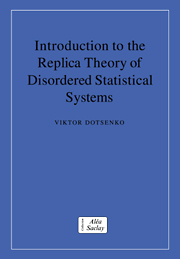Book contents
- Frontmatter
- Contents
- Preface
- 1 Introduction
- Part one Spin-glass systems
- Part two Critical phenomena and quenched disorder
- Part three Other types of disordered system
- 11 Ising systems with quenched random fields
- 12 One-dimensional directed polymers in random potentials
- 13 Vector breaking of replica symmetry
- 14 Conclusions
- Bibliography
- Index
13 - Vector breaking of replica symmetry
Published online by Cambridge University Press: 08 September 2009
- Frontmatter
- Contents
- Preface
- 1 Introduction
- Part one Spin-glass systems
- Part two Critical phenomena and quenched disorder
- Part three Other types of disordered system
- 11 Ising systems with quenched random fields
- 12 One-dimensional directed polymers in random potentials
- 13 Vector breaking of replica symmetry
- 14 Conclusions
- Bibliography
- Index
Summary
In this chapter we present a new method for studying statistical systems with quenched disorder in the low-temperature limit. The use of the replica method has turned out to be very efficient in some disordered systems. It allows for a detailed characterization of the low-temperature phase at least at the mean-field level. In all the mean-field spin-glass-like problems where one can expect the mean-field theory to be exact, the Parisi scheme of replica symmetry breaking is successful, and at the moment there is no counterexample showing that it does not work. On the other hand, the low-temperature phase of these systems is complicated enough, even at the mean-field level. One might hope that the very low-temperature limit could be easier to analyse, while its physical content should be basically the same. This very low-temperature limit is also an extreme case where one might hope to get a better understanding of the finite-dimensional problems. At first sight the low-temperature limit is indeed simpler because the partition function could be analysed at the level of a saddle-point approximation. However, it is easy to see that generically this limit does not commute with the limit of the number of replicas going to zero. There is a very basic origin to this non-commutation, namely the fact that there still exist, even at zero temperature, sample-to-sample fluctuations.
- Type
- Chapter
- Information
- Publisher: Cambridge University PressPrint publication year: 2000

